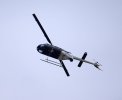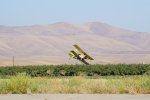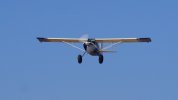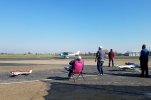Please can someone help me understand why ANY value is attached to vlos? A stupid, useless rule! I struggled to see my drones at 100m, and even when i could, would frequently lose sight of it when i glanced down at my phone. I am a trained light aircraft pilot, and know techniques such as scanning, but still couldnt figure out accurately where the drone was in relation to the ground, especially when it was high.
Then i got the goggles, and orientation became simple, regardless of distance. I could look straight down to see precisely what i was above. I never got disoriented, as north, the home point, plus the orientation of the drone and all relevant telemetry are always right there on screen. All info is available without looking away, and i don't get blinded by the sun or confused by the drone blending in with the background.
Fpv makes orientation and awareness very very easy, regardless of distance. Vlos is useless past 50m, unless you have very good eyes.
So why vlos instead of fpv?? Especially regarding safety?
Firstly, for situational awareness of the airspace around you, of course. Orienting your aircraft relative to the ground is not the primary concern. When you are flying a plane, why are you scanning? To see and avoid other traffic. Your limited FPV 70° field of view doesn't work for that at all, so you need to keep the aircraft close enough that you can see and avoid other traffic from your control point.
Secondly, loss of video/telemetry is pretty common, so you need to be able to orient your UAV and fly it back without the help of either of those. Again - that requires VLOS.
I'm really surprised that these issues would not be completely obviously to a "trained pilot". And by the way - if you can't see your drone beyond 50 m then you probably shouldn't be flying anything, manned or unmanned.
Honestly, I can "see" both sides of this 'argument'! (Pun intended)
I would say VLOS would be very important, depending on the specific model that's in the air. If it doesn't have fancy tech. Like GPS, RTH, etc. Obviously if "something goes wrong" (all short of fully losing RC) and you still have to manually fly it back to you, you're not going to be able to do that if it's outside of VLOS...
Likewise, if your AC has the tech. Even if you lose communications completely and it will "RTH" automatically, then who honestly cares if you can see it (VLOS)...
I do not buy into needing to see it to potentially yield to manned AC's, for TWO reasons! First of which being, that they're not supposed to fly below 500 ft, just like we are not supposed to fly above 400'. This means we have a 100' "safety buffer"! Okay okay I "get it", there may be a reason a drone is over 400' (shouldn't really be though) and or a manned aircraft being below 500'; which is usually near airports for ascent or descent (which would also be why that is controlled airspace in which we need LAANC approval to fly in [and chances are your 'ceiling' is then going to be less than 400' for the same reason - to avoid collisions]). So, yeah, I really do not "buy" needing to maintain VLOS "so one can yield"... The solution is simple, and is my personal SOP even though I maintain VLOS (because it is a rule), audibly hear a manned AC in the area? Descend! It's literally that simple IMHO. I don't pretend to know where a nearby manned AC may be going, or turn (and I do have MOAs near me), so if I even hear an AC anywhere nearby (by the looks of it they deviate around here a LOT according to my VFR sectional), I immediately descend until it is pretty much inaudible (gone/passed)! I don't have an exact predetermined height but I'll usually go to about 50'. If ANY manned aircraft in my area descends to 50' around here, they're going to have a LOT more serious problems than a 249 gram drone!
I also couldn't believe VLOS has anything to do with situational awareness (for said incoming manned aircraft)... I think you're much more likely to hear an inbound manned aircraft before you're going to visually see it (especially if you're also focused on your own flight & VLOS)! When I first "detect" (audibly) an aircraft, I can only imagine that it is in upwards of FIVE miles away! So I'd venture to say even if my UAV was 1 or 2 miles away (maybe even 3), clearly beyond VLOS, I'd still be able to "yield" by descending/landing, as is already my SOP!
Obviously there are almost always exceptions, just like a medical/rescue "chopper" can land just about anywhere, if they need to... I also don't think it's very difficult to discern whether an AC is merely "passing though" or if it's "coming in for a landing"! Answer remains just as simple IMHO! If you were already descending because you heard an incoming AC, once you believed/discovered it was going to land somewhere nearby, you also continue your descent until you've landed... VLOS, to some degree at that point, wouldn't matter! Sure you may be able to see where it is, but can you really see where/what you're about to land on? Even if you're only 100m out, chances are you're going to have NO CLUE what you're about to land on; except and unless you do have an uninterrupted video feed...
VLOS also becomes even less important if for any reason you lose ALL control. If for ANY reason your RC is unresponsive, it won't matter if you can see it or not, if the RC isn't working! Best thing at that point would be having an aircraft capable of "returning to home" upon any complete communications (RC) interruption/severance!
So really, I think the "importance" of VLOS entirely depends on the capabilities of your aircraft (or lack thereof)!! Doesn't mean I won't "follow the rules", because I will, as long as it is a rule; but it doesn't mean I would be against them changing or eliminating VLOS either! I do believe I would be able to pilot/operate my UAV just as safely with or without VLOS! (Depending on the capabilities of the UAV too of course)...
















